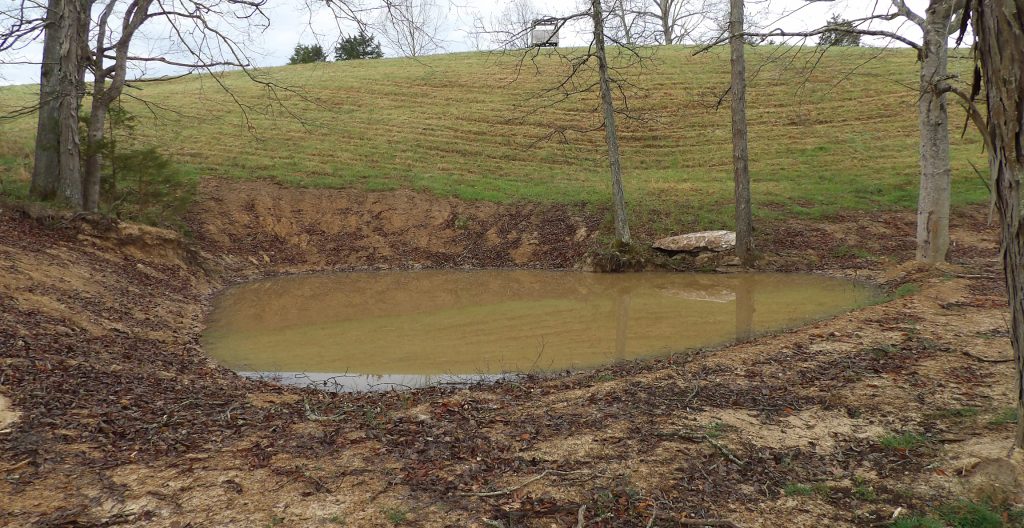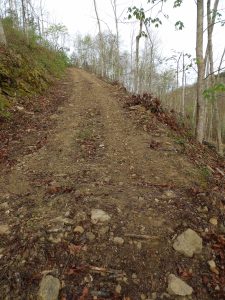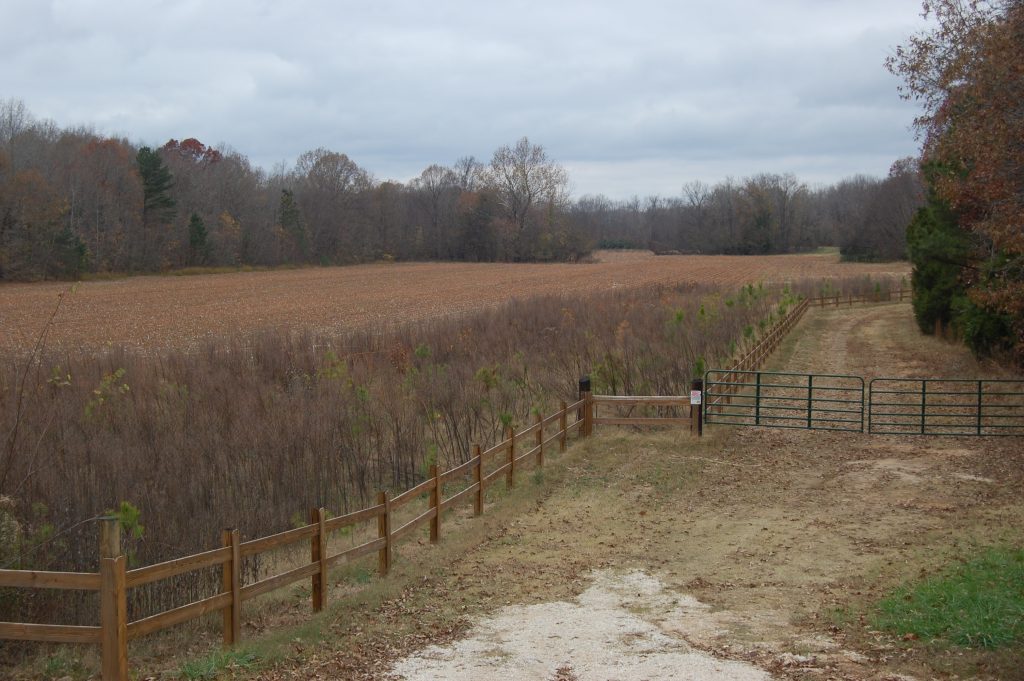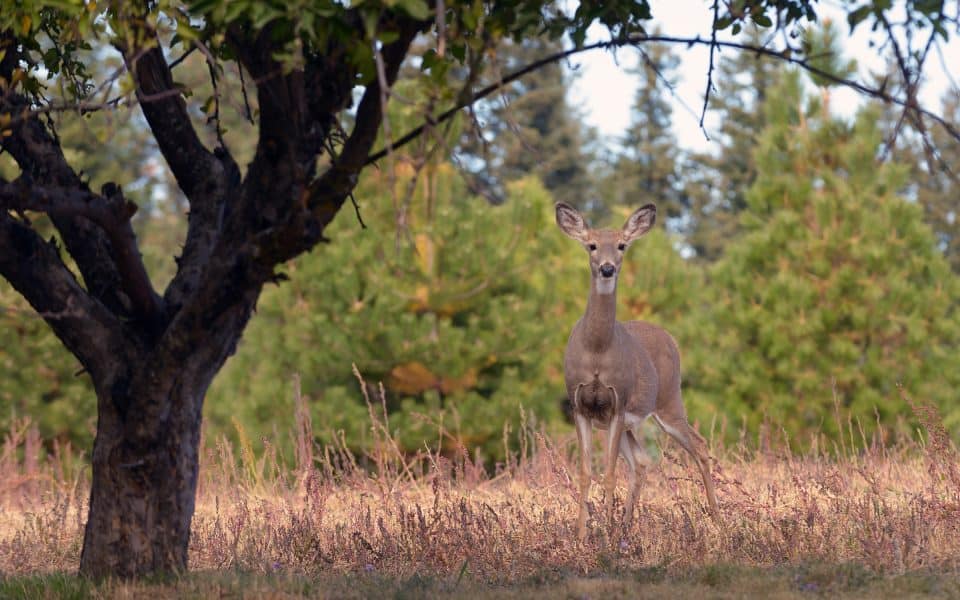Creating and maintaining an effective land management plan for wildlife should be more than a one-dimensional endeavor. For most, the thoughts of long-term land improvements go directly to the creation of lush food plots. While it’s common knowledge that a variety of food plots on your property will certainly give it instant appeal, there are also numerous projects that can have a lasting impact on both the quality of habitat and feeding options for wildlife in your area.
Creating Water Sources

Jarrod Stephens
Creating a quality water source can mean the difference between unfilled or filled tags during dry seasons. Having large water sources is wonderful but sometimes a landowner’s property may not be ideal for the creation of large ponds. Once a quality waterhole is created its impact can last for decades.
Before you begin excavating for a pond or watering hole, locate the most logical area on your property for the job. Building an effective pond consists of more than just digging a hole and praying for rain. Sandy and gravely soils will leach the water away as quickly as it collects, so finding naturally wet or spring fed areas with a higher clay content in the soil will be a great location for a water source for your wildlife.
Whenever the correct soil types are not available you can choose to use a liner that will prevent water from leaching through the porous soil. Some state conservation offices offer information and guidance for the creation of ponds, and seeking the opinions of the professionals can save you time and money.
Adding Fruit Trees
Few land improvements can have a longer lasting impact on your property than adding fruit trees to your farm. Unlike annual and perennial food plots, fruit trees will not have an instant impact but instead they will leave lasting impression. Apple trees are the most popular choice of fruit trees for hunting properties because of the abundance of varieties that are available for different planting zones.
All apple trees don’t produce their fruit at the same time so choosing varieties with varying maturity dates can spread the availability of food for wildlife over a longer period of time each fall. The magnetic appeal for falling apples is amazing for wildlife and can help you turn once unusable areas into your favorite honey holes.
Spring and fall planting of fruit trees will usually have the best results. Carefully follow the planting instruction for your trees and give them adequate amounts of water to keep the roots growing. Fruit trees should be planted in areas that receive full sunlight and can even be planted in rugged terrain that may not be tillable. To protect your young trees from eager bucks looking for a tree to rub, it is advisable to use tree protectors, cage the entire tree, or use another protective material to prevent damage.
Much like other plot options that you may have considered for your property, there are many types of fruit trees other than apple that can be added. Cherry trees, pear trees and even persimmon trees can make a consistent contribution to the overall quality and quantity of food for your wildlife. After the trees are established, they will only require an occasional trimming and annual fertilizing to reach optimal results.
Access Roads and Trails

Jarrod Stephens
Never underestimate the importance of good access throughout your property. Access to your most remote regions as well as along your property boundary can give quicker and safer access. Your roads don’t have to be the size of a highway to have a lasting impact on your property.
Adequate planning and choosing the best location for roads and trails can make the end result safer and more effective. Choose locations that are not too steep and avoid areas that will cross swampy regions. Much of the work of road creation can be completed with a tractor and frontend loader if the landscape is not too rugged or steep. While it may be tempting to simply use a chainsaw to cut a pathway to use as your trails, take caution to never leave the small stumps above ground level because they can and will puncture tires, or larger stumps simply make for a bumpy ride.
If your road crosses a ditch or small stream, you should use a drainage tile that is large enough to carry the water to create a crossing. Having a crossing that goes through a waterway can cause bank erosion and your roads will become a muddy mess. Once your roadways are created you will need to sow a fast-growing perennial on the fresh soil. The roots will stabilize the soil and prevent erosion of your hard work. A well-established and maintained roadway can last a lifetime and also help to create a fire break in the unfortunate event of a wildfire.
Diversifying Timber Stands
Timber stands, whether small or large, can be one of the most important parts of any parcel of land for habitat and feeding enhancements for wildlife. Believe it or not, simply allowing timber to grow larger is not always the best practice. Overly mature timber stands do not allow ground level vegetation a chance to grow to provide cover and food for wildlife. There are various types of timber harvests that all offer different results.
Select cutting your timber will remove the most mature trees that will also be the most valuable whenever sold. Also consider removing damaged trees or undesirable species. Initially it may seem like a bad idea, but whenever most hardwoods reach an age of eighty years or greater their quality can decline rapidly. Not to mention that their canopy shades the forest floor preventing the next generation of trees from emerging. After select trees are removed you will see immediate growth at the forest floor level since the sunlight is able to reach the ground. Young mast bearing trees will also have the potential to generate better nut crops whenever their canopy can expand and receive more sunlight.

Jarrod Stephens
Clear-cutting removes all trees from the landscape and creates the opportunity for an entirely new generation of growth to occur. While clear-cutting can have its pros such as creating excellent nesting areas for turkeys, it can sometimes have the con of the newly emerging timber being lower quality softwoods that will overtake the area. Instead of a total clear cut, considering a patch cut, where small areas of only a few acres are cut while the surrounding timber is select cut. This will create greater diversity in your forested land and more edge cover.
Mixing each of the timber harvest types is always an option which will give you the greatest benefits when managing your timber stand. Any efforts to diversify the timber stand and the edges where wildlife will find cover and sustenance will create a lasting impact. You can also use your timber earnings to reinvest back into other long term land management efforts. Always contact your state’s forestry division for their recommendations and choose a timber company that shares your vision and is certified and insured.
Establishing and Maintaining Property Boundaries
Depending on the size and location of your property, all property boundaries may not be clearly distinguished or marked. Having a clearly marked property line can prevent both intentional and unintentional encroachment from other hunters, hikers, berry pickers, or whomever. Wildlife don’t adhere to property lines and the allurement of a monster buck or boss tom may be enough for some hunters to overlook your boundary if it’s not easily distinguished. With the amount of property that is leased by hunters who may have very little knowledge of property lines, you can limit aggravation for yourself and potential intruders by clearly marking the perimeter of your property.
Before marking your property’s boundary, it is important to follow your survey closely. Having the owners of the adjoining property involved in the process can limit future issues and can cut the cost of installing fences if one is needed and they agree to cost share the supplies and installation.

Kenny Thompson
The installation of fences is not always necessary or practical, however, you can still install posts with marker ribbons in prominent locations or where neighboring hunters frequently pass by. In wooded areas where fencing is not being installed you can use your chainsaw to clear a noticeable pathway along the boundary. These pathways can become an important boundary trail as well. The simplest method of marking property boundaries in wooded areas is to tie high visibility ribbons on branches and boundary trees, or post highly visible No-Trespassing signs periodically.
Visual Barriers
Whenever your property or plots are highly visible from roadways or other properties, there is a chance that other hunters will be tempted to crowd your area in hopes of harvesting the wildlife that they’ve seen on your land. The best way to prevent such temptation is of course to plant your plots out of view of roadways, but you can also create a visual barrier to keep eyes off your prize.
Several varieties of evergreens such as the white pine have an incredibly fast growth rate and can grow to heights greater than twenty feet tall in just a few years. Evergreen varieties work best since they stay green year-round. Planting multiple off-set rows along roadways will not only create a visual barrier to keep hunter’s eyes off your fields, but will make wildlife more comfortable to come out into your food plots since they’ll be disturbed less by traffic.
Turning your Plans into Long-Term Results
Managing hunting property can be a costly endeavor which should make the importance of long-term improvements a priority. Such improvements can be carried out over a longer extent and actually become part of your annual plan for property. The results for many long-term land improvements may not be instantaneous, however, the results will benefit both the landowner and wildlife for many years to come.







